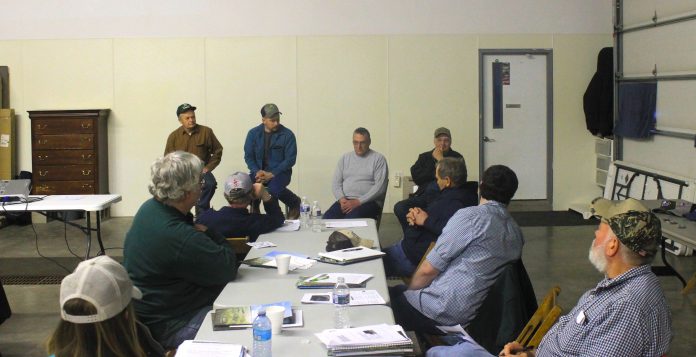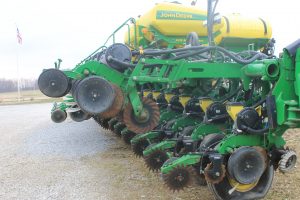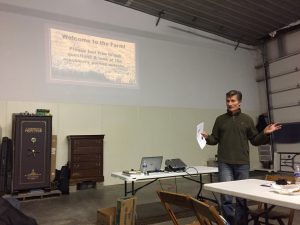
FREDONIA, Pa. — “The farmers are going faster than the research, I have to admit,” said Sjoerd Duiker, professor of soil management and applied soil physics at Penn State. “You keep challenging us.”
At their core, farmers are researchers and record keepers who continually make discoveries that should be shared.
Around 40 farmers met at Pilgram Farms in Fredonia, April 11, to share their own trial-and-error research and discuss best practices at the Mercer County Extension and Natural Resources Conservation Service cover crop field day.
“There isn’t a tried-and-true answer to any of this, we have to think outside the box,” said Bill Cannon, Mercer County farmer who has been experimenting with cover crops for 20 years.
“If we didn’t do this, we’d still be following horses around the field.”

Chris and Sandy Pilgram hosted the event in the middle of their 2,000 acres, most of which was converted to no-till in the ’90s.
“I’m not the expert in this game just yet,” said Chris, who started planting cover crops on a large scale in 2017 as part of the NRCS Conservation Security Program.
Cover crops can impact physical, chemical and biological properties, said Claire Coombs, agronomist with PSU Extension.
In Pennsylvania, 65-70 percent of acres are no-till, said Duiker.
But, he added, it is a systems approach.
“If you just stop tilling and do everything the same, you will not have a sustainable system,” he said. “The goal is diversity and to have living roots all year-round.”
There are many options with the timing of cover crop planting, terminating or harvesting.
“Really, the options and seed combinations are endless. You have to figure out what works for your farm,” Coombs said.
Start simple
Geri Montgomery, district conservationist with NRCS encouraged farmers to start simple. “You can always do more next year,” she said.
She suggested farmers ask themselves these questions:
• What is the main reason for trying cover crops? In other words, identify your top goal.
• What is your current crop? Next cash crop? What will benefit the soil in between?
• What do you have the ability to plant? “You don’t want to start cover cropping with interseeding if you don’t have a planter able to do that,” Montgomery said.
• What is my progress? Keeping track of progress is a must, she said. It might take more than one year to see benefits or bottom line movement.
Finally she told farmers not to get discouraged.

Ryan Graham, Butler County farmer agrees. “We need to be prepared for a challenge — and I think as farmers we always are.”
Graham worked for Evergreen Farms, in Spruce Creek, Pennsylvania, for three years. They milked 1,800 cows and have 70 employees, he said. This is where he first experienced no-till and it opened his eyes to the whole system.
He came back to his home farm of about 700 acres and started applying what he’d learned.
Trying something is better than nothing, he said. He’d discourage first-time cover croppers from starting with rye.
“I’m not a rye person. It gets too big and out of control,” Graham said. “Starting with rye can be too difficult and may turn people away.”
Planting green debate
Planting other crops into green cover crops or terminating them before planting is a debate, and each farmer has to experiment for themselves, he said.
“I find the most success if I plant in green and terminate two days later,” he said. “When I plant green, I didn’t have a slug problem — if I plant on a bare field, I have a big problem with slugs.”
“I’m afraid of killing good bugs too, but once you reach a threshold, you have to address it,” Graham says about putting bait out for slugs.
Bob Buhl, a farmer from Erie County, also weighed in, saying he has mixed feelings about planting into cover crops.
“If you are planting corn for grain — go for it. But, for chopping silage, I say don’t do it.”
“I’ve planted in green and it never catches up. When it’s killed, I have a bigger stalk and better yields,” Buhl said.
He was planting green for several years and then one year he had a big weed problem, so he sprayed herbicide on his cover crop before planting corn for silage and had a much better year, so he quit planting green for anything he’s chopping.
Buhl uses an interseeder with 7 ½ inch rows. Essentially, it is a no-till drill with depth control and a press wheel.
Buhl says he doesn’t have time to plant cover crops after the harvest, that’s why he uses the interseeding method.

Advice
1. Try it, try something.
2. Be prepared for a challenge.
3. Keep seeing rates low. You can always increase, but start out with a single type of seed at a low rate — then bloom into multiple species. The farmers said the biggest challenge in cover crops is planting them too thick.
5. Focus on the benefits. Benefits keep adding in a continuous loop. With no-till and cover crops, you just keep going around the circle and adding up more benefits — beneficial bugs, additional biomass, clear run off and the list goes on, Graham said.
5. Equipment maintenance doesn’t change. If you are poorly maintaining your equipment now, when you start into cover crops you will see it fail sooner.
6. Maintain pH. This is one of the most important things before you start to no-till.
“If you don’t have the money for anything else, get your pH in order,” said Cannon, a founding member of the Pa. No-Till Alliance.
5. Talk to someone. “Talk to the no-till alliance and all these people here today. That’s what it is all about — farmers helping farmers.”
New research
The latest research in cover crops includes using cover crops to graze.
Duiker has been working with farmers to integrate grazing with no-till systems. They have found that a field of corn silage which is then planted in oats and radishes is great for fall grazing, or rye and wheat for spring grazing.
“Leading no-till farmers are starting to graze. You will see in the next several years a shift — getting animals back on our land,” he said.
Whether it is grazing cover crops or adding diversity to the rotation, there is one goal.
“To reduce costs and maintain yields — that’s why we are all here,” Pilgram said.









